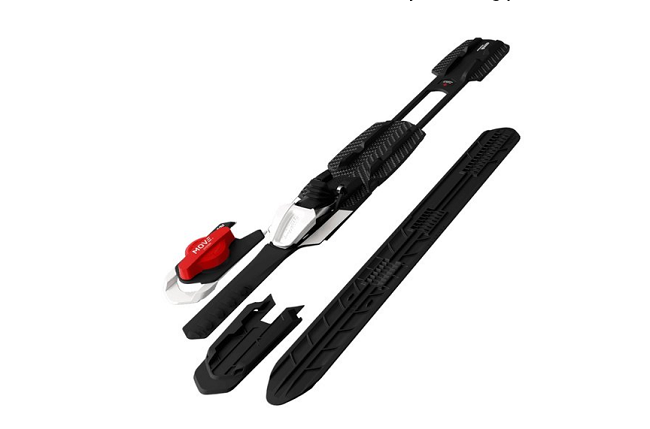What is the real value of a movable cross-country ski binding-patent?
First stop in an expensive patent dispute
July 1st. 2022, the Oslo District Court ruled in favor of Norwegian bindings and ski-companies Rottefella and Madshus in their patent case against Amer Sports (Salomon and Atomic).
This very Norwegian case, concerns patent rights for movable bindings for cross-country skis and a solution for easy adaptation and installation of bindings on the ski. Rottefella sells their product MOVE with such patented technology, while Amer has launched its binding «Shift-In» with a similar solution.
In short, Rottefella won, and the Amer Sports companies must withdraw their Shift-In bindings. For now, the verdict can be appealed. I do not want to focus on the legal details of the patent-case. Rather, I will focus on if it makes sense to spend multiple millions on patenting and enforcing rights to such a small improvement to cross-country ski bindings, and if so why?
A small advantage
Rottefellas patented solution allows you to easily regulate and adapt the ski binding’s location on the cross-country ski, preferably while on the trail.
Ten to twenty years ago, this would be considered a nice gimmick, but hardly much more. In 2022, on the other hand, this is a key patent to dominate the cross-country ski market.
Cross-country skis using synthetic skins, instead of traditional wax, to provide grip, have in a short time taken over. They provide superior grip and glide compared to the old non-wax skis and are far easier to use and maintain than wax skis. The battle for the cross-country market, is consequently now a battle to become the preferred wax-free solution.
Using skin-skis, however, the location of the pressure point on the ski is even more crucial for both grip up-hill, and glide down-hill than with wax skis. To achieve the best experience on the skin-skis your feet should be further forward on the ski for grip on steep inclines, and further back for better glide in inclines. Thus, movable bindings are the key to the best cross-country ski-experience.
But the competitive advantage does not stop there…
Rottefella Move
Amer Sports – Shift-In
A big payoff
Equally important for the value of these patents is the role of the binding as a link between the different products.
In addition to your poles, you will need skis, bindings and shoes to go cross-courtry skiing.
The shoe must fit the binding, and the binding must fit the ski. In this way, the binding acts as a key to the choice of both skis and shoes.
If you have the preferred binding patent, you can largely control the customer’s choice of skis and shoes as well. The patent determines not only which bindings you choose, but the entire ski package.
Limited costs
Patenting is expensive, and enforcing the patents even more so.
One may ask whether such processes are worth the millions the parties must be expected to spend on these patents. Cross-country skiing is, after all, a small sport with few active countries.
However, this fact will also help you reduce costs. Solutions with low production costs and universal global significance, such as pharmaceuticals, must be protected worldwide to be adequately secured. This entails very large costs with processes in each region and country and the coordination of these.
For cross-country ski-patents, this is easier. By protecting the solution in a few key markets, you will quickly have adequate protection. In the same way a method of fish farming in salt water doubtfully need protection in Switzerland, cross-country ski-patents only need protection in key states with skiing conditions.
This, together with the patents’ great importance for the market position, means that patenting probably makes very good sense for Rottefella here.
There is a lot to be saved by not uncritically patenting everything, everywhere, always. But then it is also important to see when patenting is worth it.
Perfect conditions, for the IP-strategy
A number of external factors affect the success of this IP strategy.
As mentioned, the patent has extra great value skin-skis, but also larger market trends have an effect.
Firstly, customers are less and less prone to assemble their bindings themselves. When we previously drilled and screwed the bindings on at home, you were free to choose whichever bindings you preferred. Now, the skis are usually delivered from the factory or shop with a pre-assembled fastening system, which locks you in to a given choice of binding. This is also desirable for the store, as this process allows them to compete on service, not just price and on-line sales.
A good patent alone is worth nothing. The great values of the patent have the right timing and give a lasting competitive advantage.
If Rottefella really succeeds, Move will be an integral part of the cross-country skiers’ experience of better glide and grip with skin-skis. This has value far beyond the bindings as such, by strengthening the Rottefella brand long after patent protection has expired.
Find your key advantage – And protect it
All industries can learn from Rottefella’s IP strategy here. It is not enough that the solution is technically ingenious, it needs to add value.
The solution can be simple. The real value lies in the sum of the protection and competitive advantage it provides.
 About the Blogpost Author
About the Blogpost Author
Andreas Sætre Hanssen is an Intellectual Property Lawyer, LL.M. and MIPLM, securing businesses competitive advantages using strategic IP services and management.
With his company Zipip, Andreas is building new smarter IP-services.
Andreas has a wide prior experience within IP and corporate law from The Norwegian Industrial Property Office, major Norwegian law firms, and Onsagers AS.
_________________________
IP-Management concept: Dominant Design
Dominant Design is a technology management concept identifying key technological features that become a de facto standard. A dominant design is the one that wins the allegiance of the marketplace, the one to which competitors and innovators must adhere to, if they hope to command significant market following. The firm that has brought up a dominant design shapes future generations of products.
The brand of the product must be visible and tangible for potential customers. If the customer experiences an affirmative buying experience on his buying journey, a positive customer experience is created. At the same time, the customer experience focuses on the consumer and his or her needs. In this way, a brand becomes indispensable for the customer and the customer relationship is strengthened.
Dominant design and complementary assets, explained with several examples:



